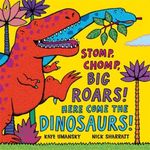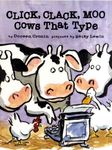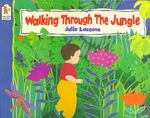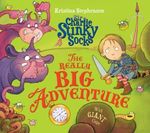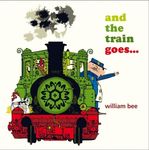Here are some ideas of books that promote Phase 1 Phonics - Avanti Schools Trust
←
→
Page content transcription
If your browser does not render page correctly, please read the page content below
Here are some ideas of books that promote Phase 1
Phonics.
and the train goes… William Bee
This is a super book for sound discrimination,
vocal, instrumental or body percussion. On each
page the train makes a different sound; you
could start with linking different instruments to
each sound (e.g. whistle for ‘woo woo’ / cabasa
for the shovel etc…). Maybe leave the tray of
instruments with the book for the children to
explore after it has been shared with them. To
challenge the children further you could link two
similar-sounding instruments (e.g. maracas for
the ‘clickerty click, clickerty clack and a cabasa
for the shovel) to see if they can work out what
the train is doing with their eyes closed
All Join In, Quentin Blake
This well-loved selection of ‘Rollicking
rhymes to read aloud’ has a great rhythm
for the children to join in with.
After reading ‘Sorting Out the Kitchen
Pans’, let the children find a selection of
objects that ting, bang, dong, clang and
bong! This is great for the outdoor area…
Adults can support and extend by asking
the children to link new vocabulary to the
sounds they hear.
Brown Bear, Brown Bear Bill Martin Jnr and Eric
Carle
The clear and simple rhythm in this text is perfect for the
children to learn and repeat. Split the class or group into
two and have one half ask the question whilst the others
respond. Picture clues in order will help to keep the pace
going (which is essential for the rhythm). Lift up each
picture clue in turn.
Make the pictures available for the children to explore
independently – maybe add a few other animals figures
in a basket for the children to improvise their own
versions. You could even prompt some alliteration with a
green goat and a pink panther.Click, Clack Moo Doreen Cronin and Betty Lewin
Once the children are familiar with this funny tale introduce
some oral segmenting as the cows type… c-l-i-ck, c-l-a-ck,
m-oo. Make some signs around your computers (or maybe
an old keyboard) as a visual reminder for the children. A
cow, chicken and duck headband or mask will excite them
too.
Linking the oral segmenting to writing is key for children to
start to understand how phonics helps us.
A Squash and a Squeeze Julia Donaldson and
Axel Scheffler
The rhyme and rhythm in this text are great models
for the children. There is some challenging
vocabulary (grouse, curious) which can be explored
with the children through drama. Create your ‘house’
with tape or skipping ropes to mark out a space
(outside is even better). As the adult reads children
act out squashing, squeezing, looking curious and
maybe even a little grousing! A few little props from
your farmyard small world play could be left out
strategically with the book for child-led exploration to
follow.
Billy’s Bucket Kes Gray and Garry Parsons
This story gives a myriad of opportunities to use a bucket
(or even mini buckets, i.e. cups!) to enhance the children’s
language. Use Billy’s under the sea idea to get started and
then open the door to anything that might live in the bucket
(dragons, dinosaurs, jungle creatures, a school for toys).
Role models are key here so listen out for children who
really extend this into their own little bucket world.
This is the Bear Sarah Hayes and Helen Craig
Lots of lovely rhyme in this story – use the opportunity for
children to predict the next word by stopping at the rhyming
word, e.g. This is the bear who fell in the bin. This is the dog
who pushed him …
Cover words with little sticky notes so that the children can be
teachers and point to the words as they retell, pausing for the
missing ones.Walking Through the Jungle Julie Lacome
You need some space for this story as the children
will want to join in! Use the opportunities to explore
both children’s own vocal sounds and to be able to
distinguish others. Once they are familiar with the text,
muddle up the order by saying the first part and then
making that sound. Progress on to the children
choosing what they will see by giving those voice
clues
The Ding Dong Bag Polly Peters and Jess
Stockham
Sound and noise are what it’s all about here! This is a
great text for spotting alliteration, rhyme and
noisiness. Following the story, the children will be
raring to collect their own sound bags and take part in
environmental sound walks. To encourage the
children to listen ca\refully and talk about different
kinds of sounds indoors and out (quiet, loud, close,
faraway, booming, whispered). If you have an Ipad or
tablet at your disposal you could collect real sounds
to share later
One Fish Two Fish Red Fish Blue Fish Dr Seuss
This is a longer text that might be best used in smaller
chunks. The rhyme and rhythm lend themselves to using
some body percussion to keep the ‘beat’ of the story as it is
read.
To promote language and vocabulary development pick out a
few of the crazy creatures to add words to (The Zeds, The
Wumps, The Zans).
What the Ladybird Heard Julia Donaldson and Lydia
Monks
This noisy farmyard tale is great to develop voice sounds
(‘moo’, ‘hiss’, ‘quack’…). Once the children know the
sounds use the outdoor area to create a giant map so that
the burglars get in a terrible muddle, just like in the story.
Two sets of cards with the animals on would be great to
help the children to decide who is making each noise. Put
one animal into a speech bubble so it is clear that this the
noise to make.Sir Charlie Stinky Socks and the Really Big
Adventure Kristina Stephenson
This book is perfect for directing attention to alliteration,
with wiggly woos and a deep dark forest, not to mention
stinky socks of course! Let the children become brave
knights afterwards with alliterative names (‘Shocking
Shihab’ or ‘Tickly Tiana’). Give the children name labels so
that names can be used all day
Gorilla Loves Vanilla Chae Strathie and Nicola
O’Byrne
Lots of rhyming pairs of words to identify in this story.
Once the children get the hang of the rhythm, let them
shout out the final word (it doesn’t matter if it’s different
to the text, or even a made-up word!), e.g.
Little Sam Sundae is known as the king
Of cornets and wafers and flavours that…
(here the children might say ‘ping’ or ‘sing’ or ‘bling’!)
Dinosaur Roar Paul and Henrietta
Stickland
Most EYFS classrooms have a stockpile of
dinosaurs lurking about. This small world play
can help the children to reproduce an oral
retelling. Explore other noisy eating words
that the dinosaurs might make (chomping,
burping, gurgling, slurping) and create cards
to go with each dinosaur. Adults can model
oral segmentation as they write and oral
blending as they read
Stomp, Chomp, Big Roars Kaye Umansky and Nick
Sharratt
Use this text alongside ‘Dinosaur Roar’ to extend children’s
language and vocabulary. Encourage the children to create
a dinosaur trail around their learning environment (a picture
and label of the relevant dinosaurs would help here). Where
would each creature go? E.g. Stomping dinosaurs outside
where they can stomp around / Friendly dinosaurs at the
table with the cups on drinking their tea / Diving dinosaurs in
the water tray / Daddy Bigfoot in the sand tray etc…Bear Snores On Karma Wilson and Jane Chapman
Lots of lovely language to draw upon in this wintery
tale. Explore quiet sounds and loud sounds with the
children by providing different materials and
instruments for them to explore (crinkly plastic, a rain
stick, a tube and a cork to go ‘pop’, chitter-chatter
speech bubbles). Can the children sort them into two
baskets or hoops one with a picture of a sleeping bear
and the other a wide-awake bear? Which ones would
wake him up? Can they use the same one quietly so
he doesn’t wake up?
Down by the Cool of the Pool Tony Mitton and Guy Parker-
Rees
When sharing this book allow the children to dance and join in
with the different creatures to support their understanding of
the new vocabulary. Build the music of the story by having an
instrument for each creature until there is a cacophony of
sound as they fall into the cool of the pool. If you have an
outdoor story area it’s even better
Happy Reading!You can also read





